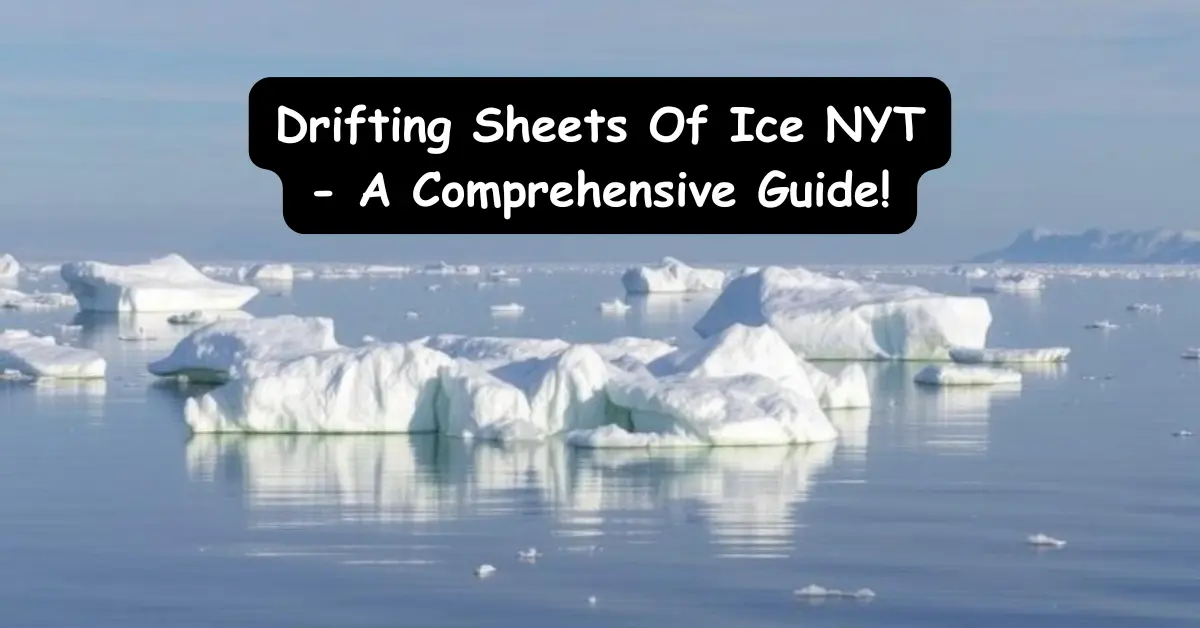Drifting Sheets Of Ice NYT – A Comprehensive Guide!
The clue “Drifting Sheets of Ice” in the NYT crossword refers to types of ice like floes, pack ice, and icebergs. Understanding these terms aids in solving the puzzle and appreciating their significance.
Table of Contents
Understanding the Clue: Drifting Sheets of Ice NYT:
When you come across the clue “Drifting Sheets of Ice” in the New York Times (NYT) crossword puzzle, it might seem tricky at first. This clue is related to different types of ice that float on water. Knowing more about these types of ice can help you solve the crossword puzzle and learn something new at the same time!
The Crossword Connection
Crossword clues often use words that relate to the answer in some way. The phrase “drifting sheets of ice NYT” refers to large areas of ice that can be found floating in oceans and large lakes. Here are some common terms you might find related to this clue:
Floes
Floes are large, flat pieces of ice that float on water. They can be small or quite big, and they often break apart due to wind and ocean currents. You might see ice floes in polar regions or during winter in colder climates. In crossword puzzles, “floes” is often a go-to answer for clues about drifting ice.
Pack Ice
Pack ice is formed when many ice floes come together, creating a large area of ice that covers part of the ocean. Pack ice is common in areas like the Arctic and Antarctic. This type of ice can be thick and can drift long distances due to ocean currents. If you see clues mentioning pack ice, it’s likely connected to drifting sheets of ice NYT.
Icebergs
Icebergs are huge chunks of ice that have broken off from glaciers or ice shelves. They float in the ocean and can be very large—some are even taller than buildings! While icebergs are not technically sheets of ice, they are related and can often be part of the conversation about drifting ice in crossword puzzles.
Also Read: Mydearquotes.com Casino – Our Ultimate Gaming Destination!
Hints to Solve Drifting Sheets of Ice NYT Crossword Clue:
When you encounter the clue “Drifting sheets of ice NYT,” here are some tips to help you find the right answer:
- Think About Ice Types: Remember the words “floes,” “pack ice,” and “icebergs.” One of these might be the answer.
- Consider the Context: Ask yourself where you might see drifting ice. Picture polar regions or discussions about climate change.
- Use Other Clues: Look at the other answers in the crossword. They can give you letters that help you figure out the answer to this clue.
Full List of Answers to Today’s NYT Mini Crossword:
In today’s NYT Mini Crossword, the answers for “Drifting sheets of ice NYT” might include:
ACROSS
- Floes (5 letters)
- Pack (4 letters)
DOWN
- Icebergs (8 letters)
- Glacier (7 letters)
Scientific and Cultural Significance:
Understanding drifting sheets of ice NYT is important not just for crossword puzzles, but also for science and culture.
Climate and Environmental Impact
Drifting sheets of ice NYT, especially in places like the Arctic and Antarctic, play a vital role in our planet’s climate. They reflect sunlight and help keep the Earth cool. However, as temperatures rise due to climate change, these ice sheets are melting faster. This melting contributes to rising sea levels, which can cause flooding in coastal areas. Keeping track of these changes helps scientists understand how our climate is changing.
Cultural and Historical Context
Ice has played a significant role in the lives of people, especially those living in Arctic regions. Indigenous communities have relied on ice for hunting and fishing for generations. They have valuable knowledge about the ice and its changes. Learning about these cultural connections helps us appreciate how important ice is to both the environment and different ways of life.
Also Read: Eiyuu To Kenja No Tensei Kon Novel – Detailed Introduction!
Best Word Games to Play After the NYT Mini Crossword:
If you enjoy solving the NYT Mini Crossword, you might also like these engaging word games:
- Wordle: A daily word puzzle where players guess a five-letter word within six attempts. It’s a great way to challenge your vocabulary and word association skills.
- Scrabble: This classic board game involves creating words on a game board using letter tiles. The longer the word, the more points you earn, making it both strategic and fun.
- Crossword Puzzles: Try exploring other themed crossword puzzles available online or in local newspapers. Each puzzle offers different challenges and themes to keep your mind active.
- Boggle: A fast-paced word game where players find as many words as possible in a grid of letters within a limited time. It’s exciting and can be played solo or in groups.
- Sudoku: While not a word game, Sudoku offers a different kind of challenge. It involves filling a grid with numbers based on logic, enhancing problem-solving skills.
FAQs:
1. What are floes?
Floes are large, flat pieces of ice that float on water, commonly seen in polar regions or during winter in colder climates.
2. What is pack ice?
Pack ice is formed when multiple ice floes come together, creating a large area of ice that drifts in the ocean, particularly in Arctic and Antarctic regions.
3. What are icebergs?
Icebergs are massive chunks of ice that break off glaciers or ice shelves and float in the ocean. They can be much larger than buildings.
4. How does melting ice affect climate change?
Melting ice contributes to rising sea levels, which can lead to flooding in coastal areas and impacts the Earth’s climate balance.
5. What other word games can I play?
After the NYT Mini Crossword, consider playing Wordle, Scrabble, Boggle, or Sudoku for more word-related challenges.
Conclusion:
Understanding the clue “Drifting Sheets of Ice” in the NYT crossword enhances your puzzle-solving skills and deepens your awareness of environmental issues. Ice plays a crucial role in our climate and has significant cultural implications, especially for indigenous communities in polar regions. Recognizing terms like floes, pack ice, and icebergs can help you connect more deeply with the science and culture surrounding ice. Explore related word games for continued engagement and fun!







